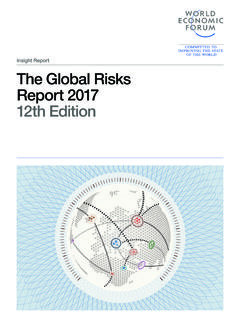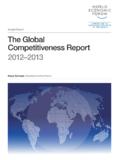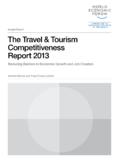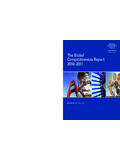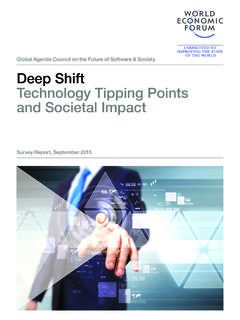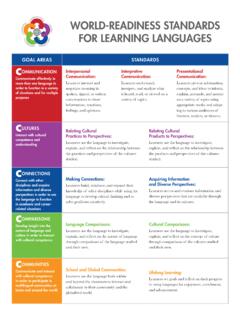Transcription of WEF a new circular vision for ... - World Economic Forum
1 January 2019A New circular vision for ElectronicsTime for a Global RebootIn support of the United Nations E-waste CoalitionPLATFORM FOR ACCELERATING THE circular ECONOMYPLATFORM FOR ACCELERATING THE circular ECONOMYPLATFORM FOR ACCELERATING THE circular ECONOMYW orld Economic Forum91-93 route de la CapiteCH-1223 Cologny/GenevaSwitzerlandTel.: +41 (0)22 869 1212 Fax: +41 (0)22 786 2744 Email: views expressed in this publication are those of the authors and do not necessarily reflect the views of the United Nations (UN)-system entities. The UN and its contributory organizations do not accept responsibility for the accuracy or completeness of the contents and shall not be liable for any loss or damage that may be occasioned, directly or indirectly, through the use of, or reliance on, the contents of this publication.
2 The designations employed and the presentation of the material in this publication do not imply the expression of any opinion whatsoever on the part of the UN and its contributory organizations concerning the geo-political situations or the legal status of any country, territory, or city or area or their authorities, or concerning the delimitation of their frontiers or boundaries. Mention of the names, logos of companies and their commercial products does not imply affiliation to or endorsement of the UN and other contributory organizations. In no event, the UN and its contributory organizations respective names and emblems, or any abbreviations thereof, shall be used for commercial Platform for Accelerating the circular Economy (PACE)This report is published as part of the Platform for Accelerating the circular Economy (PACE).
3 PACE is a public-private collaboration mechanism and project accelerator dedicated to bring-ing about the circular economy at speed and scale. It brings together a coalition of more than 50 leaders and is co-chaired by the heads of Royal Philips, the Global Environment Facility and UN Environment. It is hosted by the World Economic Forum . The E-waste Coalition This report supports the work of the E-waste coalition, a group of seven UN entities that havecome together to increase cooperation and more efficiently provide support to Member States and Parties to address the e-waste challenge. The coalition brings together: the International Labour Organization (ILO); the International Telecommunication Union (ITU); the United Nations Environment Programme (UNEP); the United Nations Industrial Development Organization (UNIDO); the United Nations Institute for Training and Research (UNITAR); the United Nations University (UNU), and the Secretariat of the Basel and Stockholm Conventions.
4 It is supported by the World Business Council for Sustainable Development (WBCSD), the World Health Organization (WHO) and the World Economic Forum and coordinated by the Secretariat of the Environment Management Group (EMG).3A New circular vision for Electronics: time for a Global RebootContentsForewordExecutive SummaryE-waste definedThe scale of e-wasteTrendsResource scarcity, extraction and emissionsBatteries: An electrifying issueA System ErrorConsumer relationship with electronicsLack of recyclingLabour, environmental and health issuesLegislation on e-wasteWhere is e-waste generated The Economic value of e-waste Delivering a zero e-waste circular economy A system upgrade: Change to the circular economyElectronics as a service?
5 Economic benefit and job creationConclusionContributorsEndnotes56 7910111112121213131415161617181920214A New circular vision for Electronics: time for a Global Reboot5A New circular vision for Electronics: time for a Global RebootForewordWe have come together as the heads of UN agencies with the World Economic Forum and the World Business Council for Sustainable Development to address a severe global challenge while also simultaneously grasping a massive opportunity. Electronic goods, from solar mini grids to smartphones, bring huge benefits to humankind and offer new opportunities for development. They present new tools to address the challenges of climate change, expand education, deliver healthcare and facilitate trade.
6 Digitalization and connectivity are also critical to help achieve all 17 Sustainable Development Goals. At the same time , the current system of production and consumption is ready for a reboot. In the mining, manufacturing, transport, retail, consumption and disposal of electronics, there are vast amounts of wasted resources and the system has several negative impacts. Each year, approximately 50 million tonnes of electronic and electrical waste (e-waste) are produced, equivalent in weight to all commercial aircraft ever built; only 20% is formally recycled. If nothing is done, the amount of waste will more than double by 2050, to 120 million tonnes it is not being stored in cellars, drawers and cabinets, e-waste is often incinerated or dumped in landfills, or makes its way around the World to be pulled apart by hand or burned by the World s poorest, to the detriment of health and the environment.
7 That same e-waste represents a huge opportunity. The material value alone is worth $ billion ( 55 billion), three times more than the annual output of the World s silver mines and more than the GDP of most countries. There is 100 times more gold in a tonne of mobile phones than in a tonne of gold ore. Furthermore, harvesting the resources from used electronics produces substantially less carbon-dioxide emissions than mining in the earth s crust. Working electronic goods and components are worth more than the materials they contain. Therefore, extending the life of products and re-using components brings an even larger Economic benefit. There is also an opportunity to build a more circular electronics system, one in which resources are not extracted, used and wasted, but valued and re-used in ways that create decent, sustainable jobs.
8 In short, we need a new vision for electronics. This report combines data and research from throughout the UN system to make the case for a new vision . Describing and analysing challenges and opportunities, and laying the groundwork for the process of systemic change is just the first step. To make this happen, the following are required: vision : Society needs to collectively rethink the rules of the game and create a vision around which government, consumers and industry can rally Awareness: The public needs to learn more about this growing global challenge and opportunity Collaboration: This coalition seeks to work with multinationals, small and medium-sized enterprises (SMEs), entrepreneurs, employers associations, academia, trade unions, civil society and associations in a specific and deliberative process to bring about change.
9 Public-private collaborations through platforms such as PACE and the E-waste Coalition will play an important role Action: Coordinated action by all actors is needed within and across national bordersHoulin Zhao, Secretary-General, International Telecommunication UnionJoyce Msuya, Acting Executive Director, United Nations Environment ProgrammeNikhil Seth, Executive Director, United Nations Institute for Training and ResearchGuy Ryder, Director-General, International Labour OrganizationDominic Waughray, Head of the Centre for Global Public Goods, Member of the Managing Board, World Economic ForumLI Yong, Director General, United Nations Industrial Development OrganizationDavid M.
10 Malone, Rector, United Nations UniversityPeter Bakker, President of the World Busi-ness Council for Sustainable DevelopmentRolph Payet, Executive Secretary of the Basel, Rotterdam and Stockholm Conventions6A New circular vision for Electronics: time for a Global RebootRapid innovation and lowering costs have dramatically increased access to electronic products and digital technology, with many benefits. This has led to an increase in the use of electronic devices and equipment. The unintended consequence of this is a ballooning of electronic and electrical waste: is difficult to gauge how many electrical goods are produced annually, but just taking account of devices connected to the internet, they now number many more than humans.

